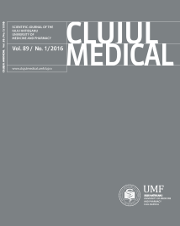Synergistic effects induced by combined treatments of aqueous extract of propolis and venom
DOI:
https://doi.org/10.15386/cjmed-527Keywords:
propolis, venom, breast cancer, apoptosisAbstract
Background and aims. Breast cancer is a heterogeneous disease and the leading cause of cancer mortality worldwide. Triple negative breast cancer (TNBC) is considered to be one of the most aggressive breast neoplasia due to failure of chemotherapy response. Thus, there is an urgent need of finding alternative therapies for TNBC. This study was designed to evaluate the synergistic effect induced by propolis and bee venom on luminal (MCF-7) and TNBC (Hs578T) cell lines.
Methods. In order to evaluate the synergistic effect of aqueous extract of propolis and bee venom, we treated in combination two breast cancer cell lines: MCF-7(luminal subtype) and Hs578T (TNBC subtype).
Results. Our results indicate that both cell lines exhibited similar sensitivity to the aqueous extract of propolis at a dilution of 0.072-0.09 mg/ml. The results concerning IC50 forbee venom on MCF-7 cells was 1 mg/ml, 20 times higher than 0.05 mg/ml in Hs578T cells. By combining the aqueous extract of propolis with bee venom, we obtained synergistic effects at a higher concentration, which was 5 and 2 times stronger than the two treatments alone.
Conclusion. Overall, the results from our study indicated that the combination of aqueous extract of propolis and bee venom treatments induced synergistic antiproliferative effects in a concentration-dependent manner in breast cancer cells. Thus we can hypothesize that the combination of honeybee propolis and venom might be involved in signaling pathways that could overcome cells resistance to therapy.
Downloads
Published
How to Cite
Issue
Section
License
The authors are required to transfer the copyright of the published paper to the journal. This is done by agreeing to sign the Copyright Assignment Form. Whenever the case, authors are also required to send permissions to reproduce material (such as illustrations) from the copyright holder.

The papers published in the journal are licensed under a Creative Commons Attribution-NonCommercial-NoDerivatives 4.0 International License.

